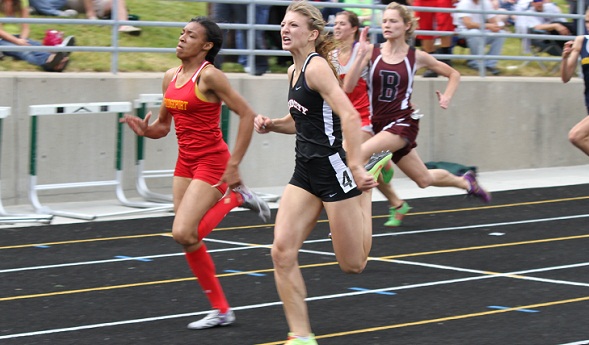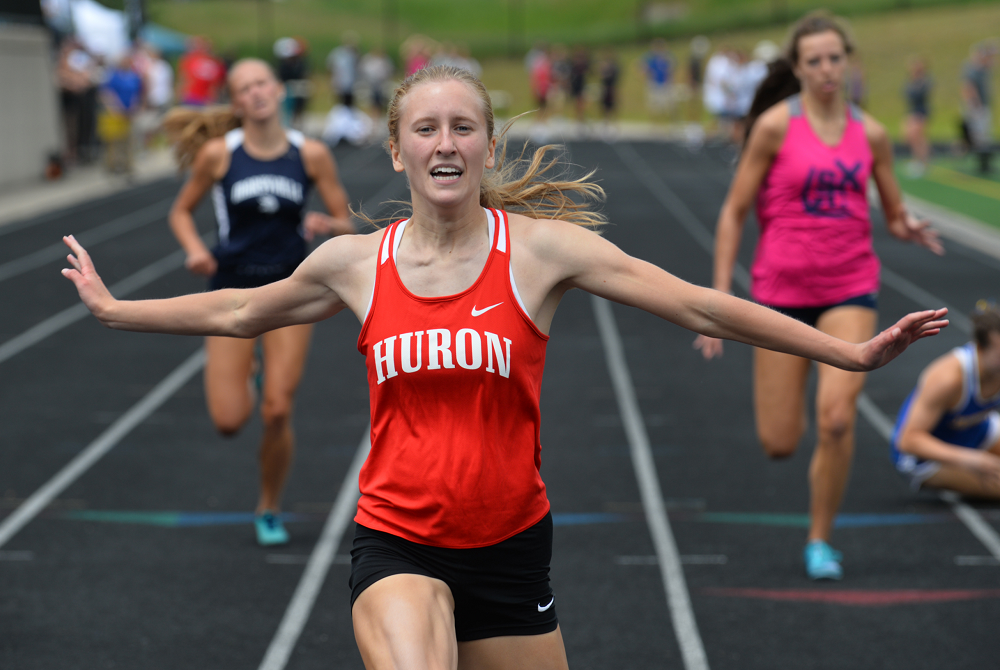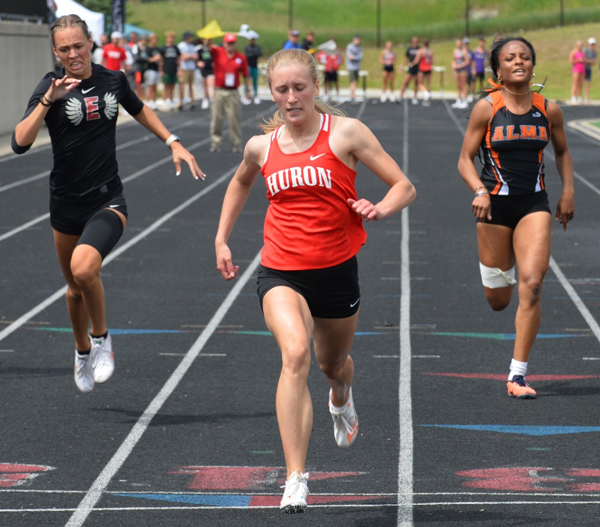
Reed City's Sami has Spring in her Step
June 6, 2012
By Geoff Kimmerly
Second Half editor
Sami Michell knows her starts could be better. And she's sure she can improve her arm position when she’s going over hurdles.
The Reed City junior is a self-admitted perfectionist. And she’s already thinking about next season.
The rest of Michigan should watch out.
Michell established herself as one of the top hurdlers in MHSAA history at Saturday’s Division 3 Final while becoming the first in Lower Peninsula girls history to win four events at a championship meet since Mason County Eastern’s Maria Shoup in 1979. And she’s got a few more goals she’d like to achieve before moving on to a future that's looking brighter with every stride.
"I'm always thinking about next year and what I want to do, the times I want to run -- even after I won four events Saturday," Michell said. "I want to run a faster 200 and get the Division 3 record, and I want to get the all-division record in the 100-meter hurdles. It's just not hard for me to think about it. I know there are things I don't do perfectly."
Michell gets a Second Half High 5 this week as arguably the brightest of an incredible group of stars who combined to break 19 meet records during Saturday's Finals.
She set Division 3 milestones in three events at Comstock Park – the 100 hurdles (13.84 seconds), 300 hurdles (42.23) and long jump (18-6.5). Her 300 hurdles time also broke the all-Finals record set by Benton Harbor’s Carolyn Ferguson in 1984.
The four championships gave her eight total with a season left to compete. She just missed winning four in 2011 as well – she finished runner-up in the 200, five hundredths of a second back. But her mom Vikki, also Reed City’s girls track and field coach, knew something special was coming long before Sami’s first high school competition.
At a youth meet when Michell was 10 or 11, she won the long jump – despite being so much smaller than her opponents that when she climbed to the top step of the medal stand, she still stood shorter than the runner-up next to her but a level below.
Soon after, Michell began pulling out her smaller 12-inch hurdles during her parents’ practices – dad Brent is the Reed City boys coach – and during seventh grade, she was able to switch from four-step to three-step hurdling. That step was a significant one in helping her go from good to great.
In her first high school race, Michell broke her mom’s school record in the 100 hurdles that had stood since 1987.
“She had made the finals (as a youth) but never won sprints. But I knew as a coach, if I could get her to love hurdles, with her speed, if she perfected her hurdling form, she’d go a long way,” said Vikki Michell, who also ran at Ferris State. “I never honestly dreamed she’d go (this far).”
In some key ways, Michell is a natural for hurdles and jumps. She’s 5-foot-8, but with more than half of her height in her legs. She’s pushing 30 inches in the vertical jump, good enough to touch the metal that connects the rim to the backboard on a basketball hoop. She’s been her volleyball team’s setter since freshman year, and this fall also began playing middle blocker.
But her rise to elite didn’t come without work to back up that talent – fueled by that aforementioned attention to detail.
Reed City is about two hours drive from the nearest indoor track facility, so Michell spends winters running the 75-meter straightaway of her school’s main hallway. The uncharacteristic warm winter allowed her to continue training on the school’s track into January, but often she competes in winter indoor meets to also take advantage of a rare opportunity to practice hurdles and long jump.
She’s also doing some heavy lifting, literally, taking a class daily and focusing on squats and other lifts that have increased her leg strength significantly over the last two years.
“She’s a dedicated person. She doesn’t do anything halfway, I can say, as both her coach and her mom,” Vikki said.
As a child, If Sami made any kind of mis-mark on a math assignment, she’d tear it up and start over – but got over that after realizing how much extra homework she was doing. She's ranked first academically in her class, with a 4.0, and for a long time she did everything she could extra to get 100 percent in every class. These days, she's decided she'll be good with a 95, as long as it still gets her an A.
She'll work on track skills with both parents, but does plenty of research on her own watching YouTube videos of the best from her sport.
Michell likes winning, like anyone else. But she's possibly more driven by distaste for losing.
"I get frustrated. Kinda disappointed and mad at the same time," she said.
"I guess I just hate losing when other people just think they're fast. It's so much fun to just beat them."
And she can do so in more ways than what she showed Saturday. Michell also is the fastest in school history in the 400 with a time of 56.83. She ran the 800 only once, in 2:24.9, and she’s run the 100 three times, the fastest in 12.39. Those 400 and 100 times also would've been good enough for first place at this Division 3 Final.
Clemson, Michigan State and Stanford are among those showing the most early interest in her post-high school plans, and she'll likely hear from many more when college coaches can contact her later this summer.
Click to read more about Michell's track family connection and future plans.
PHOTO: Reed City's Sami Michell (center) edged Bridgeport's Kimberly Balls (left) in the 200-meter race at the Division 3 Final at Comstock Park. (Photo courtesy of RunMichigan.com.)

Multi-Sprint Champ Racing to Finish Huron Career Ahead of the Rest Again
By
Keith Dunlap
Special for MHSAA.com
May 25, 2023
NEW BOSTON – If there was one thing Elizabeth Anderson took pride in elementary school, it was simply showing that she could outrun everyone in sight.
 In fact, Anderson has an explanation for all the success she had in those playground races.
In fact, Anderson has an explanation for all the success she had in those playground races.
“Dominance when you are in elementary school,” Anderson quipped. “I don’t think I ever had a nickname. I just think everyone knew I was fast.”
Years later, pretty much everyone who follows track & field in the state of Michigan can attest to that.
A senior for New Boston Huron, Anderson has been faster than most other competitors in the state during her three-year high school career (with her freshman season in 2020 canceled due to COVID-19).
Last year, Anderson won titles at the Lower Peninsula Division 2 Finals in the 200-meter (25.07) and 400-meter (56.28) dashes, and was runner-up in the 100-meter dash (12.23).
Often, top sprinters focus on one or two of those three races. But Anderson is certainly a different breed of sprinter because she does all three.
In fact, she holds school records in all three of those events, and if all that weren’t enough, Anderson is a part of all three sprint relay teams.
“It is hard to give her events off,” said New Boston Huron head girls track coach Danielle Lobato.
Despite the different styles the 100, 200 and 400-meter dashes present, Anderson said there usually isn’t much adjusting when she goes from one of those races to another.
 The strategy is simply, “Let’s beat the other girls to the finish line.”
The strategy is simply, “Let’s beat the other girls to the finish line.”
“I don’t really go into each race changing up how I would run,” she said.
While enjoying and succeeding in all three races, Anderson said she actually does have a favorite among them.
“I would say the 400 is probably my favorite,” she said. “Even though it hurts, it’s satisfying to see how much you can get your time down in the 400 compared to any other race.”
Anderson said she started running track in sixth grade, but really got serious about it during the summer after her sophomore season, when she was invited to run for a local club.
Eventually, that led to her competing over the winter in indoor events.
She lived and breathed track so much that last fall, she decided to not run cross country so she could focus on a weightlifting regimen aimed at developing more leg strength.
“Once I started doing summer track, I realized I wanted to be doing this all the time,” she said.
Lobato said oftentimes in practice, Anderson is a de facto coach, given there is no better person she can think of for the younger runners on the team to learn from.
“I can’t always demonstrate these things I’m trying to teach,” she said. “You get to see it in real life (from Anderson), not in a YouTube video.”
After winning the 100, 200 and 400-meter dashes at her Regional meet last week, Anderson has her sights set on achieving the same trifecta of titles at next Saturday’s Finals in Grand Rapids.
Anderson has signed to run track at Michigan State, but has been plenty motivated to keep producing this spring in her final high school season.
“I’m really looking to defend my titles,” she said. “That is what is really motivating me to keep going. I want to keep in shape for the college season. I don’t want to lose any of the progress I have made. Ultimately, I just love running track.”
And since elementary school, Anderson has loved — and succeeded in — outrunning everyone else to the finish line.
“We knew we were getting something special,” Lobato said of when Anderson arrived in high school. “But you never expect this. All that she has accomplished is amazing.”
 Keith Dunlap has served in Detroit-area sports media for more than two decades, including as a sportswriter at the Oakland Press from 2001-16 primarily covering high school sports but also college and professional teams. His bylines also have appeared in USA Today, the Washington Post, the Detroit Free Press, the Houston Chronicle and the Boston Globe. He served as the administrator for the Oakland Activities Association’s website from 2017-2020. Contact him at [email protected] with story ideas for Oakland, Macomb and Wayne counties
Keith Dunlap has served in Detroit-area sports media for more than two decades, including as a sportswriter at the Oakland Press from 2001-16 primarily covering high school sports but also college and professional teams. His bylines also have appeared in USA Today, the Washington Post, the Detroit Free Press, the Houston Chronicle and the Boston Globe. He served as the administrator for the Oakland Activities Association’s website from 2017-2020. Contact him at [email protected] with story ideas for Oakland, Macomb and Wayne counties
PHOTOS (Top) New Boston Huron's Elizabeth Anderson clears the finish line during last season's LPD2 400 race. (Middle) Anderson, middle, outpaces the field to also win the 200. (Click for more from RunMichigan.com.)

